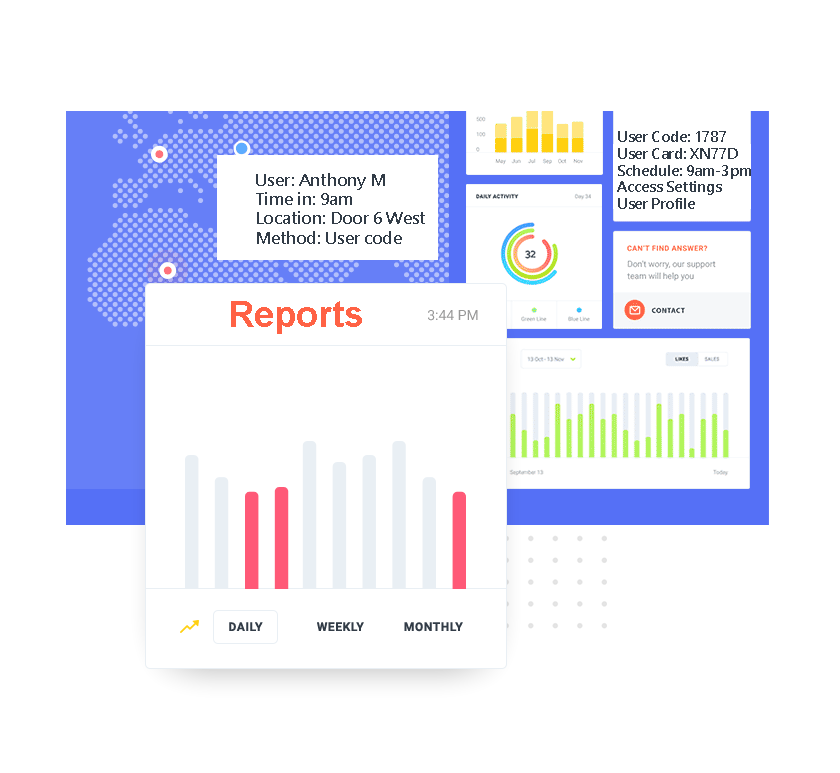Access Control
What is access control?
Access control is a security system that helps regulate who or what can view or use assigned resources in a computing environment. It is a necessary tool in security in order to protect data or a physical location.
There are two types of access control:
1. Physical access control limits access to doors and other locking or automated physical assets.
2. Logical access control limits connections to data, computers networks and system files.
To secure a facilities we use electronic access control systems that rely on user credentials, card readers, biometric and producing reports and provides user management to track employee access to restricted locations and proprietary areas, restrict entry to rooms and buildings, as well as alarms and remote control capabilities, to prevent unauthorized access or operations.
On this page you can learn about the different types of physical access control products available at Smart Access.


Stand Alone System
A standalone system is an application that does not need to be bundled with other software or applications, it’s a system with a software that can “stand on its own” without help from the Internet or another processor computer.

Network Access Control
Access control systems with network connection and remote software or mobile app. These systems provide user tracking, user management, remote control features and integration with other security systems.
The Benefit Of Access Control System
Security: The primary benefit of access control is the security it provides. By controlling who has access to a facility, an access control system can help prevent unauthorized access and reduce the risk of theft, vandalism, and other security breaches.
Convenience: Access control systems can be configured to allow access to authorized individuals at specific times and locations. This can be convenient for both employees and facility managers, as it eliminates the need for keys and reduces the risk of lost or stolen keys.
Accountability: Access control systems can track who has entered and exited a facility, and when they did so. This can be useful for security purposes, as it allows facility managers to know who was present in the event of an incident.
Cost savings: An access control system can save a facility money in the long run by reducing the need for security guards and the cost of rekeying locks when keys are lost or stolen.
Enhanced safety: Access control systems can be configured to restrict access to certain areas or resources based on an individual’s role or job duties. This can help to ensure that only authorized personnel have access to potentially hazardous areas, which can help to enhance safety.
There are several different types of components that are commonly used in access control systems:
Card readers: Card readers are used to verify an individual’s identity by reading a card or badge that has been encoded with the individual’s information. Card readers can be standalone units or can be integrated into other access control devices, such as turnstiles or doors.
Keypads: Keypads are used to allow individuals to enter a code in order to gain access to a restricted area. Keypads can be standalone units or can be integrated into other access control devices, such as doors or gates.
Biometric scanners: Biometric scanners are used to verify an individual’s identity based on unique physical characteristics, such as a fingerprint, iris scan, or facial recognition.
RFID (radio-frequency identification) systems: RFID systems use radio frequency technology to communicate with RFID tags or cards. When an individual with an RFID tag or card approaches an RFID reader, the reader can communicate with the tag or card to verify the individual’s identity.
Turnstiles: Turnstiles are used to control access to a restricted area by allowing only one person to pass through at a time. Turnstiles can be controlled by card readers, keypads, or other access control devices.
Door controllers: Door controllers are used to control access to doors by allowing only authorized individuals to open the door. Door controllers can be standalone units or can be integrated into other access control devices, such as card readers or keypads.
Access control software: Access control software is used to manage and control the various components of an access control system. It can be used to set access permissions, track access events, and generate reports.
Online access control systems VS Offline access control system
Online access control systems, also known as cloud-based or hosted access control systems, are systems that are managed and controlled remotely over the internet. Local offline access control systems, on the other hand, are systems that are managed and controlled locally on the premises. Here are some of the benefits and downsides of online and local offline access control systems:
Benefits of online access control systems:
Remote management: With an online access control system, facility managers can manage and control the system from anywhere with an internet connection. This can be convenient for managing multiple locations or for managing a system remotely.
Automatic updates: Online access control systems can be automatically updated with the latest software and security features, which can help to ensure that the system is always up to date and secure.
Scalability: Online access control systems can be easily scaled up or down as needed, making them a good option for facilities that may experience fluctuations in the number of users or the level of security needed.
Reduced maintenance: Online access control systems typically require less maintenance than local offline systems, as the service provider is responsible for maintaining the system.
Downsides of online access control systems:
Dependence on internet connectivity: Online access control systems rely on internet connectivity to function, which can be a drawback in areas with unreliable or unavailable internet service.
Potential security risks: There is a risk that an online access control system could be hacked or compromised, which could compromise the security of the facility.
Higher upfront costs: Online access control systems can be more expensive to implement than local offline systems, as they require a subscription or monthly service fee.
Benefits of local offline access control systems:
No dependence on internet connectivity: Local offline systems do not rely on internet connectivity to function, which can be an advantage in areas with unreliable or unavailable internet service.
Greater control: With a local offline system, facility managers have more control over the system and can make changes and updates directly on the premises.
Potential cost savings: Offline systems are relatively less expansive
Downsides of local offline access control systems:
Limited remote management: With a local offline system, facility managers must be on site to make changes or updates to the system.
Lack of automatic updates: Local offline systems do not receive automatic software and security updates, which means that they may become outdated over time.
Limited scalability: Local offline systems may be more difficult to scale up or down as needed, making them less flexible than online systems.

Functional Dashboard
- Admin and manager access
- User notifications
- Instant remote features
- Free software no subscription
- Reports
Live Notifications
Smart notifications, custom your notifications to match your security needs.

